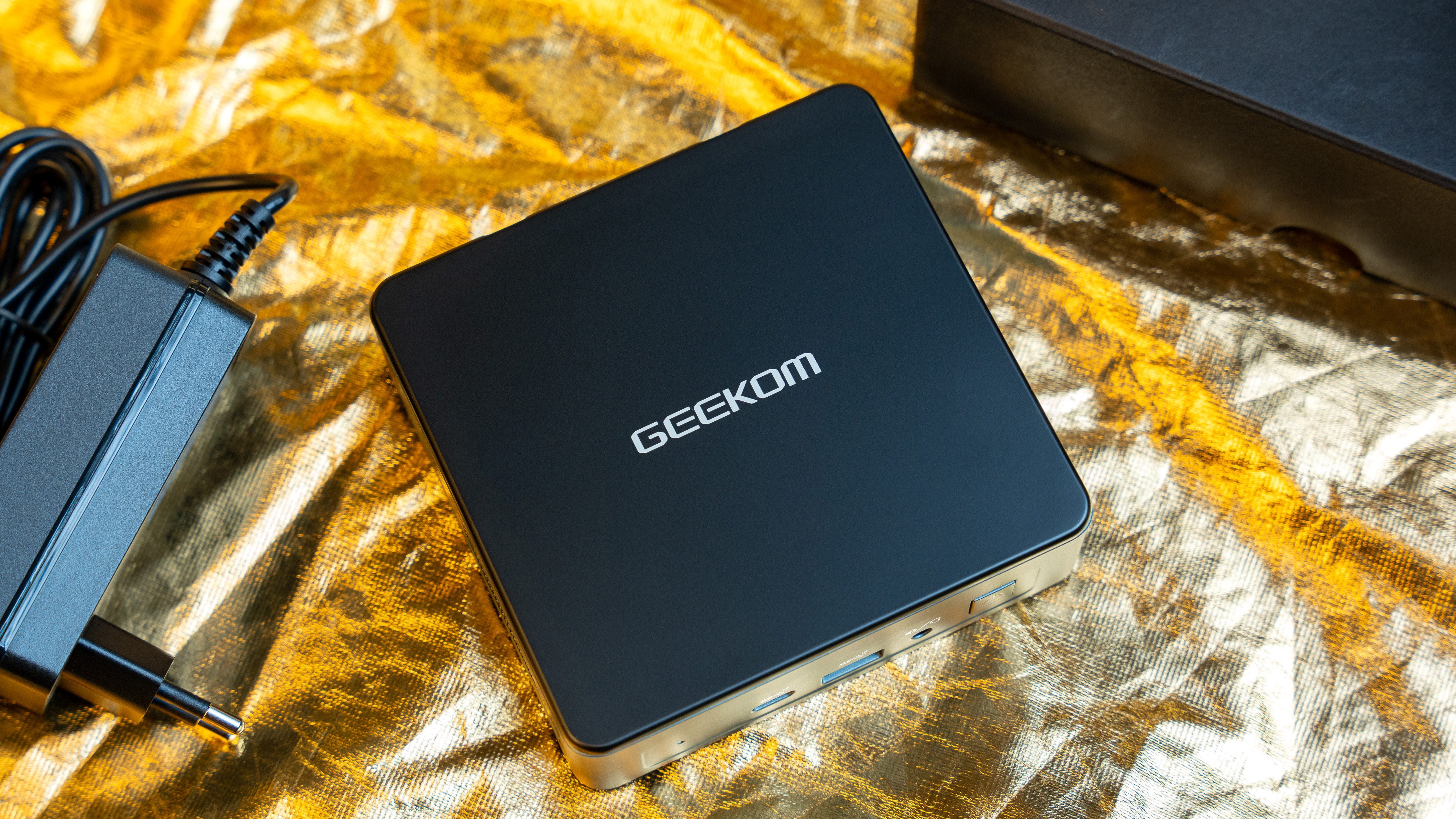
With the Mini Air 12, Geekom offers a particularly affordable and tiny mini PC. With a case size that measures just 11.7 x 11.2 x 3.42 cm and costs $249 onward, the question arises: Is this the perfect solution for a home office setup? More importantly, is the PC sufficient to handle more intensive tasks such as image editing or computer games? Let’s find out in this review!
Good
- Particularly great at energy-saving
- Sufficient performance for office use
- Nice and quiet, even under full load
- Fast SSD
Bad
- Hardly a performance champion
- No slot for additional SSD
- Only one DDR5 RAM slot
- Equipped with only HDMI 2.0 and USB 3.2 ports
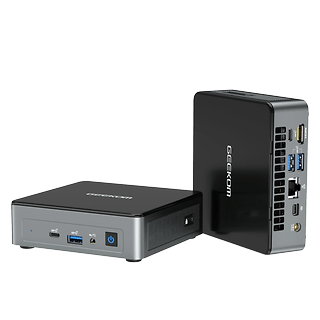
Geekom Mini Air 12: All deals
The Geekom Mini Air 12 in a nutshell
If you are looking for the cheapest and most energy-efficient mini PC possible, the Mini Air 12 from Geekom is a good choice. In addition to the low power consumption, it operates quietly. Although the SoC from Intel’s Alder Lake generation is more powerful than the Celeron CPU in its predecessor, it does not offer much of a performance gain. If you are bothered by long loading times and perform plenty of tasks in the background, you might be better off with a more expensive model.
This review was written in collaboration with Geekom. It does not influence the content or editorial opinion.
Design & processor
The Mini Air 12 from Geekom is similar in size to its predecessor. With a case size measuring 117 x 112 x 34.2 mm, it is one of the thinnest Mini PCs around from the manufacturer. Unfortunately, this comes at the expense of expandability but the build quality is generally very good. The connectivity options also impressed us as a home office machine.
Pros:
- Very compact and lightweight design.
- A solid variety of connections.
- High build quality.
Cons:
- 2.5″ SSD can no longer be used.
- Only comes with HDMI 2.0 connectivity.
In the past, Geekom’s Mini PCs offered a good mix of expandability in a compact form factor. This is because models like the Mini IT 13 (for review) or Geekom AS6 (for review) could also be installed with a 2.5″ HDD or SSD in addition to the integrated SSD. Since the Mini Air 12’s case is a little flatter, you will have to forgo this option.

However, Geekom’s signature high build quality remains. The Mini Air 12 looks as though it was cast from a single mold and does not creak when pressed or a heavy load is placed on top. The range of connections is still decent. Check out all the available ports are listed below:
- Front
- 1x USB 3.2 Gen 2 (USB-A).
- 1 x USB Type C.
- 1 x 3.5mm headphone jack.
- Power button.
- Left side
- Right side
- Rear side
- 2 x USB 3.2 Gen 2 (USB-A).
- 1 x USB Type C.
- 1 x Mini DisplayPort 1.4.
- 1 x RJ45 Ethernet port.
- 1 x HDMI 2.0 connection.
- 1 x DC socket.
The fact that up to three screens can be connected to the Mini Air 12 is a positive point. Unfortunately, it does not support Thunderbolt via USB C, which means the Mini PC cannot be used with a compatible display. HDMI 2.0 is also not as popular as it was in 2024, but resolutions higher than 4K are not recommended anyway given the low-cost hardware.
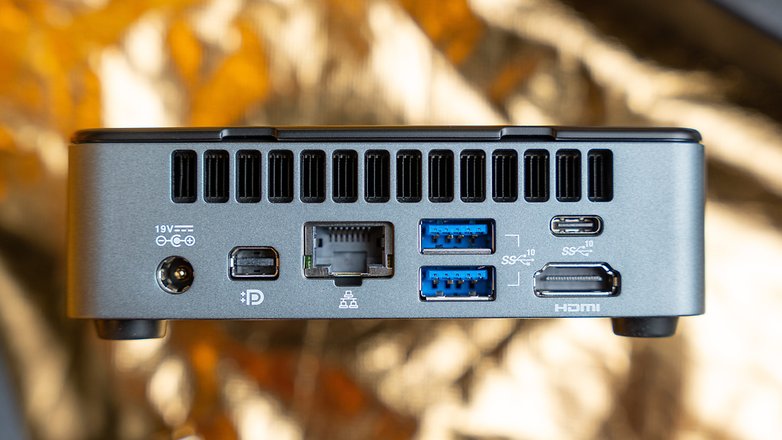
Compared to more expensive mini PCs from Geekom, it was striking how quietly the Mini Air 12 operates. As the processor produces less heat, the fans hardly have to work at all. I only heard the fan awaken from its slumber during strenuous work sessions and when playing games. Even then, ut just sounded like an ordinary notebook fan. I didn’t find this annoying in a quiet home office setup.
Operating system
Geekom offers the Mini Air 12 with Windows 11 pre-installed. The installed operating system is an OEM version and thus cannot be transferred to other computers. However, Geekom allows the installation of dual boot OSes, allowing you to install a second operating system.
Pros:
- Windows 11 comes pre-installed.
- Dual booting is possible.
Cons:
- Windows 11 OEM version is non-transferrable.
Windows 11 is a good operating system for office use and gaming. The fully-fledged OS offers you all the trappings that modern operating systems come with. In my opinion, Windows has also become a little more accessible recently. If you’re not familiar with computers at all, you can write emails or set up a text document in a jiffy thanks to the app store and integrated features.
If you want to experience more, you can also install another operating system for a dual booting experience. Unfortunately, there is no option to switch to Linux completely and extract the Windows key. In my opinion, this is the only disadvantage concerning the operating system, and the less said about it, the better.
Performance and internal components
The Mini Air 12 is an affordable and therefore, not particularly powerful mini PC. Our review unit came with an Intel N100 processor from the Alder Lake generation. It has 16 GB DDR5 RAM at its disposal with 512 GB of internal memory as Geekom relies on a fast M.2 PCIe SSD. WiFi 6 and Bluetooth 5.2 connectivity are also on board.
Pros:
- Finally, DDR5 RAM!
- Good read and write speeds.
- “Okay” performance for office use.
Cons:
- Extremely low TDP for processor.
- Maximum 16 GB RAM and 2 TB internal storage.
Most people who buy the Mini Air 12 will use it primarily as a work computer. It should be energy-efficient and perform tasks such as browsing, word processing, video playback, and possibly even simple video editing without any issues. The Mini Air 12 proved to be sufficient for this scenario in the review. However, I cannot fully understand the configuration of the small computer.
Geekom equipped the Mini Air 12 with an Intel N100 processor from the Alder Lake generation. This relies on four processor cores, which were exclusively designed for efficiency. While Intel’s i-processors have both efficiency and performance cores, the Mini Air 12 has to make do with comparatively low-performance processors. This has a positive effect on the power consumption, which we can see from the thermal design power of just 6 W.
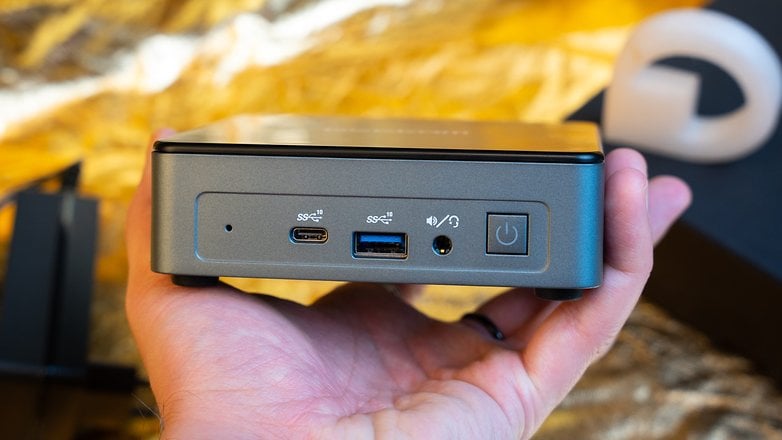
For an ultrabook or a Chromebook, this would definitely be an advantage as the processor would be particularly energy-efficient. However, the Mini Air 12 only works with a power brick, so it is questionable whether the hardware needs to be that energy-efficient. In addition, the inexpensive processor can only handle a single RAM bar. Even though Geekom now relies on DDR5 RAM according to the manufacturer’s specifications, only a maximum count of 16 GB is available. In other words, the RAM count cannot go higher than what you get.
In our review, this configuration was sufficient for all the applications we needed to publish articles. We were even able to edit a 33-megapixel RAW photo in Lightroom with occasional lag and wait times. However, we were using a brand-new operating system. The performance will presumably decrease over time as more background processes accumulate.
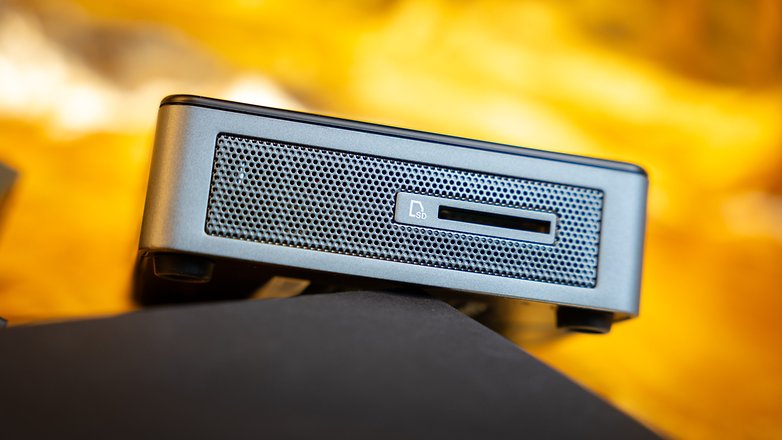
In short: If you can spend a little bit more money on a Mini PC, you should do so. The performance of the Mini Air 12 is the bare minimum of what you can buy in 2024. Even models like the Geekom Mini IT 12 from 2022 (review) exceeded such performance many times over. We can confirm this in the benchmark results of the affordable Mini PC:
Benchmark table
| Test | Geekom Mini Air 12 | Geekom Mini IT 12 | Geekom Mini IT 13 | Geekom A5 | Geekom AS 6 | Geekom Mini IT 11 |
|---|---|---|---|---|---|---|
| Geekbench 6 | 3,302 | 11,774 | 20,600 | 16,783 | 26,376 | 17,434 |
| AS SSD Benchmark 2.0 read | 2,725.82 MB/s | 4,403.83 MB/s | 3,826.72 MB/s | 3,044.12 MB/s | 3,068.19 MB/s | 2,799.02 MB/s |
| AS SSD Benchmark 2.0 write | 1,941.97 MB/s | 3,631.72 MB/s | 3,905.83 MB/s | 2,673.83 MB/s | 1,787.49 MB/s | 2,238.32 MB/s |
| Copy speed SD reader with SanDisk SD | up to 90 MB/s | up to 90 MB/s | up to 90 MB/s | up to 90 MB/s | – | up to 90 MB/s |
Where the Mini Air 12 scores points is in the write and read speeds. Here, the Mini PC is on par with the Geekom AS 6. However, it is regrettable that it is not possible to insert a second SSD or HDD into the case.
Power supply
Geekom equipped the Mini Air 12 with a new power supply unit that is significantly more compact. This was probably made possible thanks to the low power consumption of the processor. This makes the Air 12 particularly energy-efficient but it still cannot be powered via USB C.
Pros:
- More compact 45 W power supply unit.
- Particularly energy-saving.
Cons:
- Still not possible to power it via USB-C.
In the “power supply” category, the question to ask is whether the energy efficiency of the CPU has a positive effect on power consumption. We measured the power consumption of the Mini Air 12 directly at the socket. In normal office mode, we measured a constant consumption of 6 W. When playing games, the consumption then rose to a mere 16 W. With these values, the Mini Air 12 is indeed particularly energy efficient. For comparison: We measured a power consumption of 60 W under full load on the Mini IT 13 that runs on an Intel i9 processor.
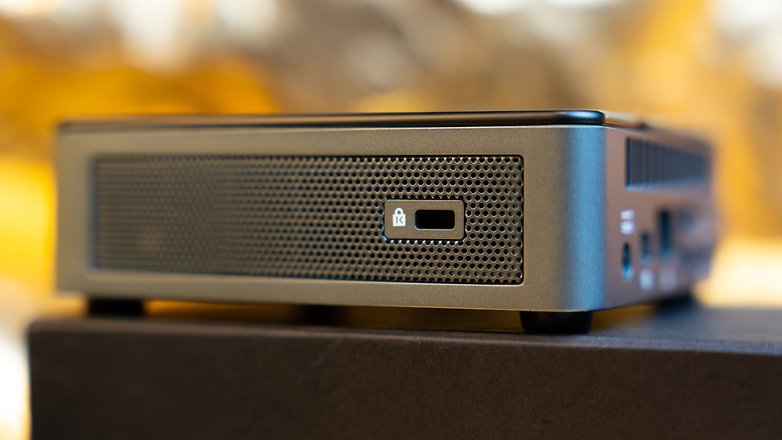
Geekom also managed to include a more compact power supply unit in the box thanks to the economical processor. This is more reminiscent of a smartphone charger with a maximum output of 45 W. However, it is again regrettable that Geekom does not enable power delivery via USB-C. This would be practical to transform the mini PC into an all-in-one PC when mounted to the back of a monitor. You will then only need one power socket with compatible monitors.
Conclusion
With the Mini Air 12, Geekom bade goodbye to the outdated Intel Celeron processors. As our review showed, this was a very important decision for Geekom’s Mini Air series. This is because the new processor offers a higher performance level and remains energy-efficient even under high load. As the efficient processor produces little heat, the Mini Air 12 is also the quietest Geekom PC we have been able to review to date.
However, if we were to look at the Mini Air 12 and compare it with other models in the market, a few shortcomings become apparent. For instance, the processor only supports a single RAM bar, making it impossible to upgrade. A second SSD will not find any room due to the Mini Air 12’s smaller case. Ultimately, however, it is the performance limitations that impair the Mini Air 12, making us hesitant to recommend the Mini Air 12.
While the built-in SoC has enough power for office use, it is not adequate for anything more. If background processes accumulate in Windows over a longer period of use or you work with multiple programs simultaneously, you will quickly reach its performance limits. As Geekom and other manufacturers already offer significantly more powerful Mini PCs at a slightly higher price point, it makes sense to opt for a more powerful alternative to cater to the possibility of numerous usage scenarios.
If you are interested, take a look at our Mini PC “Best Of” list. However, if you are going to use the Mini Air 12 solely for streaming TV series and movies or need to save some money, this is the right purchase for you!







